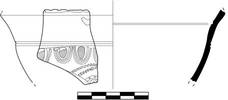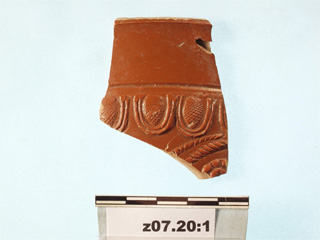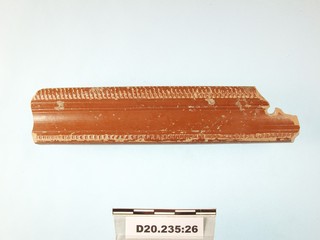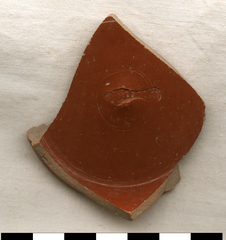Greek, Roman and Byzantine Pottery at Ilion (Troia):
Sebastian Heath and Billur Tekkök, Editors
Italian Sigillata
Please note that this is a public draft of work in progress
As used at Ilion, the term "Italian Sigillata" refers to the well-made red-slipped tableware either from Italian workshops or made in an Italian style. This qualification is necessary because, as stressed by C. Wells in his introductory note to the 1990 Conspectus of "Italian-type" forms, "an archaeologist can no longer presume to tell by the unaided eye where a piece of sigillata was manufactured." Nonetheless, "Italian Sigillata" remains current as a name () so it is used here. Given the location of the site, however, it is not unreasonable to think that the vessels listed below are all of Italian manufacture, not just of Italian appearance and form. Widespread production of red tablewares in Italy extends from the mid-first century into at least the 2nd century AD, though no examples of the distinctive later material are listed below. At no point is Italian Sigillata common at Ilion, though its appearance does indicate the site's integration into the long-distance exchange networks facilitated by the rise of Roman power in the Mediterranean.
1. Italian Sigillata Conspectus Form 12.1 Rim (Mid- to Late Augustan)
P. H. .029. Est. diam. rim .30 (1/16 preserved). Th. .0039.
K/L16/17.0467:2. Single sherd. Pale pink fabric (2.5YR 7/6), deep red slip (10R 4/6) worn in places but otherwise evenly applied to achieve a high sheen.
Cf. form 12, p. 72, plate 11.
svg/K-L16-17.0467-2.jpg
2. Italian Sigillata Conspectus Form 12.5 Rim (Mid- to late Augustan)
P. H. .021. Est. diam. rim .18 (<1/20 preserved). Th. .0042.
K/L16/17.0467:1. Single sherd preserves 1/20 rim circumference. P.H. .021, D. rim 18, Th. .0042. FPale pink fabric (2.5YR 7/6), deep red slip (10R 4/6) worn in places but otherwise evenly applied to achieve a high sheen.
Cf. p. 72, plate 11.
svg/K-L16-17.0467-1.jpg
3. Italian Sigillata Chalice (Tiberian-Claudian)
z07.0020:1. SC09-2c. Two joining sherds. Hard-fired, orangish core. Very fine surface with chunks of lime on the surface.
First published as , no. 13. Cf. R 9.3.1, p. 178, plate 58.
z07.0020-1.jpg
4. Italian Sigillata Conspectus Form 18.2.1 Rim
P. H. .03. Est. diam. rim .30 (1/20 preserved). Th. .0057.
K17.0129:1. SC09-2a. Single sherd with wall and beginning of floor. Reddish brown (2.5YR 5/6) fabric, very fine with no inclusions visible. Very glossy dark red (near 10R 4/8) slip on all surfaces, flaking in places.
Cf. form 18.
K17.0129-1.jpg
5. Italian Sigillata Conspectus Form 18 (Early First Century AD)
P. H. .029. Est. diam. rim .42 (1/10 preserved). Th. .0063.
D20.0235:26. Rouletting around rim. Pierced hole on rim. Preserving over 1/10 of rim and wall. Pinkish buff fabric with thick red slip.
Cf. form 18.
svg/D20.0235-26.jpg
6. Italian Sigillata Conspectus Form 20.4 Rim (Domitianic)
P. H. .03. Est. diam. rim .295 (1/12 preserved). Th. .0044.
K/L16/17.0169:2. Two non-joining sherds with wall and beginning of floor. Reddish brown (2.5YR 6/3) fabric, very fine with occasional light inclusions. Very glossy dark red (near 10R 4/8) slip on all surfaces, flaking in places. Rouletting on upper and lower molding.
Cf. form 20.
svg/K-L16-17.0169-2.jpg
7. Italian Sigillata Conspectus Base 12
P. H. .03. Est. diam. rim .295. Est. diam. base .08 (1/12 preserved). Th. .0037.
M18.0435:1. Red (near 2.5YR 6/4) highly compact fabric with essentially no inclusions. Deep red (25.YR 4/8) slip on all surfaces, smoothed on interior, brushed on exterior. Two concentric incised grooves on floor, positioned just inside of high ring foot.
Cf. p. 158, Abb. 6. This type of foot is associated only with Conspectus form 20. Its relative height suggests a date in the second half of the first century.
svg/M18.0435-1.jpg
8. Italian Sigillata Conspectus Form 20.5.2 Rim
Est. diam. rim .165.
y07.0458:1.
Cf. form 20.5.2.
y07.0458-1.jpg
9. Italian Sigillata Conspectus 20.4 Plate Rim (Mid 1st Century AD)
z06.0017:3. SC09-2c. Single rim sherd. Legs of striding figure in appliqué extant on outer face of rim.
First published as , no. 12. Cf. 20.4, p. 86, plate 18; where this form is said to "the most common form of plate in contexts of the mid first century AD."
z06.0017-3.jpg
10. Italian Sigillata Conical Cup, cf. Conspectus Form 22 (early-mid 1st century AD)
P. H. .026. Th. .024.
K17.0071:22. Single rim sherd. Fine pale red (2.5YR 6/6) fabric with very rare tiny light inclusions. Slip is dark red (nearest 2.5YR 4/8). Some voids , one visible on surface (.005 in length).
First published as no. 4. Cf. form 22.
K17.0071-22.jpg
11. Italian Sigillata Conspectus Form 22 Type Base (perhaps Augustan)
. P0638. "CVB" in rectangular stamp.
First published as , no. 19. Cf. form 22. For stamp 2373 (near 36, without dot), C. Vibenius Faustus (Arezzo).
svg/P0638.jpg
12. Italian Sigillata Conspectus Form 22 Type Base (Tiberian)
. P0637. "HERMAI" in planta pedis.
First published as , no. 21. Cf. form 22. For stamp see 926, Hermaiscus (Pozzuoli); no. 18 for this potter is a planta pedis looking right with toes not separately rendered.
svg/P0637.jpg
13. Italian Sigillata Conspectus Form 23.2 Conical Cup (50-100)
P. H. .033. Est. diam. rim .07 (1/4 preserved). Th. .02.
K/L16/17.0100:6. Single rim sherd. Fine pale red (2.5YR 6/6) fabric with very rare tiny light inclusions. Slip is dark red (nearest 2.5YR 4/8). Molded double scroll on outer face of rim.
Cf. form 23.
svg/K-L16-17.0100-6.jpg
14. Italian Sigillata Cup with Everted Rim, cf. Conspectus 27.1 (Mid 1st Century AD)
P. H. .025. Est. diam. rim .10 (1/20 preserved).
K/L16/17.0474:12. Single sherd. Fine fabric is light red (10R 6/6). Dark red slip (10R 4/8) is evenly applied on all surfaces. The exterior is smoothed, the interior shows brush marks.
p. 100, pl. 25. Among the most common forms in the South Stoa deposit at Corinth.
svg/K-L16-17.0474-12.jpg
15. Italian Sigillata Cup with Everted Rim, cf. Conspectus 32.1.1
P. H. .019. Est. diam. rim .07 (<1/20 preserved).
z06.0017:2. SC09-2e. Single rim sherd. Fine fabric is light red (10R 6/6). Dark red slip (2.5YRR 4/8) is evenly applied on all surfaces. Three bands of rouletting on exterior surface, applied scroll on upper surface of rim.
First published as no. 10. form 32.1.1.
z06.0017-2.jpg
16. Italian Sigillata Chalice. Cf. Conspectus R2 or R3 (Augustan to Tiberian)
P. H. .046. Est. diam. rim .18 (1/8 preserved). Th. .0025.
K17.0848:1. Single sherd. Very fine, light red (2.5YR 6/6) fabric with no visible inclusions. Dark red (near 10R 4/8) slip, high gloss.
R2 or R3.
K17.0848-1.jpg
General Bibliography
Ettlinger, Elisabeth. 1990.
Conspectus Formarum Terrae Sigillatae Italico Modo Confectae Materialien zur römisch-germanischen Keramik 10. Frankfurt am Main.
[
worldcat.org]
Marabini Moevs, Maria Teresa. 2006.
Cosa: the Italian Sigillata Memoirs of the American Academy in Rome Supplementary Volume 3. Ann Arbor.
[
worldcat.org]
Oxé, August, Howard Comfort
and Philip Kenrick. 2000.
Corpus Vasorum Arretinorum, 2nd Edition Antiquitas 41. Bonn.
[
worldcat.org]
Poblome, Jeroen, Peter Talloen, Raymond Brulet
and Marc Waelkens. 2004.
Early Italian Sigillata. The chronological framework and trade Patterns BABESCH Annual Papers on Classical Archaeology Supplement 10. Leuven.
[
worldcat.org]
Tekkök, Billur. 2003.
“Troy from the Julio-Claudian to the Flavian Period: its connections with the Mediterranean World,” Rei Cretariae Romanae Fautorum Acta 38: 237-242.
Related Resources for Catalog
These links provide well-known identifiers for concepts appearing in this catalog.




















